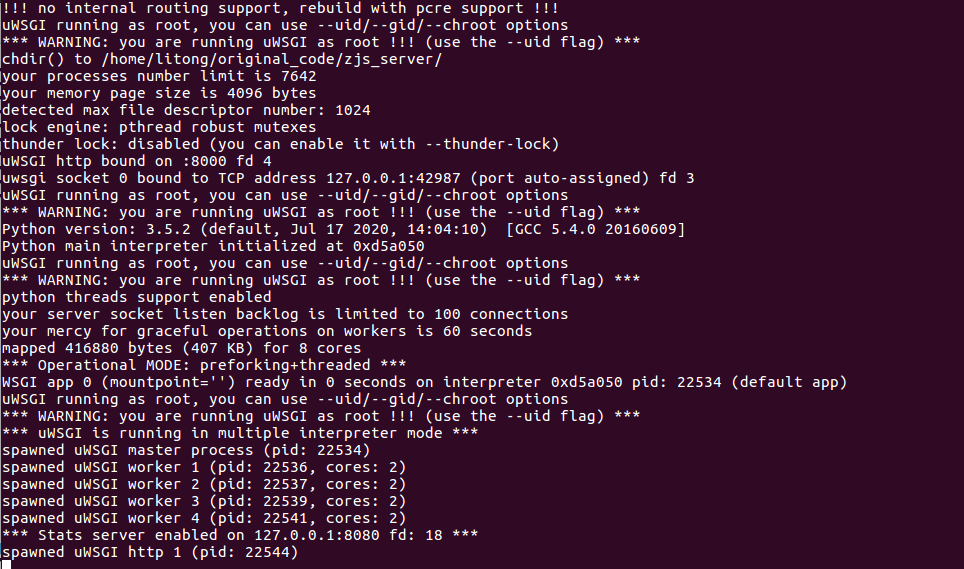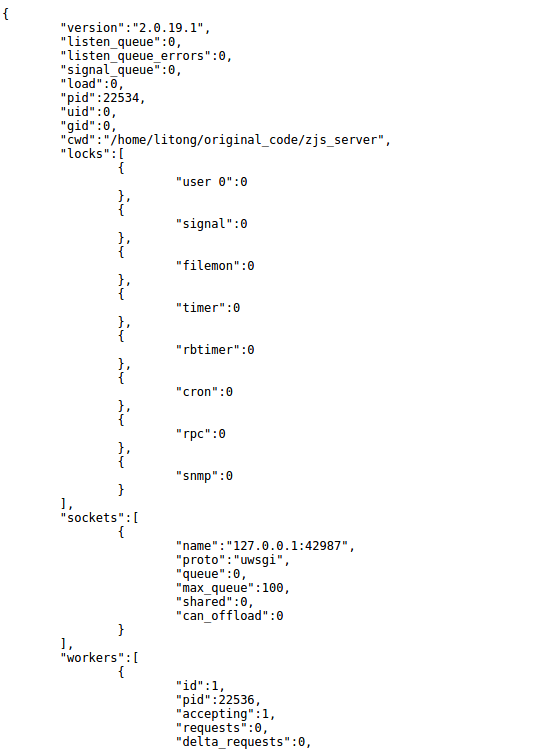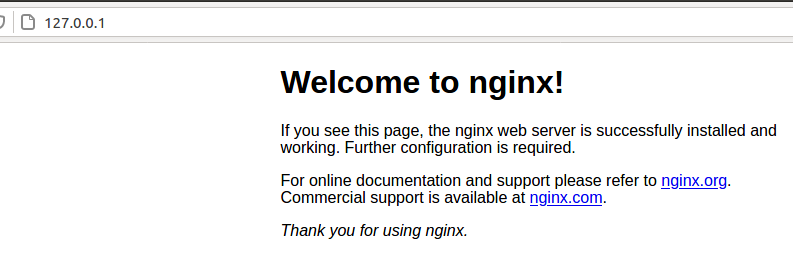django+nginx+uwsgi+vue部署服务器
一、首先需要配置django+nginx+uwsgi
1. 安装虚拟环境
2. 安装项目所需要依赖的包
sudo pip3 freeze > requirements.txt
pip3 install -r requirements.txt
3. 安装和配置uwsgi
安装uwsgi
pip3 install uwsgi
在/opt文件下建立文件
vi /opt/uwsgi.ini
对uwsgi文件配置如下
[uwsgi] # 项目目录 chdir=/home/litong/original_code/zjs_server module=ipm2020.wsgi:application # the virtualenv (虚拟环境的绝对路径) home = /home/litong/.virtualenvs/manpeng2 #热重载 #touch-reload = /opt/ipm2020 #py-auto-reload = 1 # 指定sock的文件路径 #socket=/home/litong/proj/script/uwsgi.sock #或者指定地址直接(指定文件路径就是相当于单独写了个配置导入,相当于import导入,可以修改和删除,可维护性高点) #socket=127.0.0.1:9090 使用nginx连接时使用 socket=0.0.0.0:9090 #直接做服务器用http模式 直接做web服务器使用 python manage.py runserver ip:port http=0.0.0.0:9500 # 进程个数 workers=1 pidfile=/(%chdir)/uwsgi/uwsgi.pid # 指定静态文件,这个项目中没有,如果你的项目中有静态文件的话按这个目录结构配置 #static-map=/static=/home/litong/proj/ # 启动uwsgi的用户名和用户组 uid=root gid=root # 启用主进程 master=true # 自动移除unix Socket和pid文件当服务停止的时候 vacuum=true # 序列化接受的内容,如果可能的话 #thunder-lock=true # 启用线程 enable-threads=true # 设置自中断时间 #harakiri=30 # 设置缓冲 post-buffering=4096 # 设置日志目录 #daemonize=/opt/uwsgi/uwsgi.log
uwsgi常用参数介绍
chdir=/xxx/xxx # 指定项目目录 home=/xxx/xxx # 指定虚拟环境变量 wsgi-file=xxx # 指定加载WSGI文件 socket=xxx # 指定uwsgi的客户端将要连接的socket的路径(使用UNIX socket的情况)或者地址(使用网络地址的情况)。 callable=xxx # uWSGI加载的模块中哪个变量将被调用 master=true # 指定启动主进程 processes=4 # 设置工作进程的数量 threads=2 # 设置每个工作进程的线程数 vacuum=true # 当服务器退出时自动删除unix socket文件和pid文件 logfile-chmod=644 # 指定日志文件的权限 daemonize=%(chdir)/xxx.log # 进程在后台运行,并将日志打印到指定文件 pidfile=%(chdir)/xxx.pid # 在失去权限前,将主进程pid写到指定的文件 uid=xxx # uWSGI服务器运行时的用户id gid=xxx # uWSGI服务器运行时的用户组id procname-prefix-spaced=xxx # 指定工作进程名称的前缀
uwsgi的启动与停止
启动: uwsgi --ini 配置文件路径 例如:uwsgi --ini uwsgi.ini
停止: uwsgi --stop uwsgi.pid 路径 例如:uwsgi --stop uwsgi.pid
配置完成之后测试uwsgi是否安装成功。
在随意位置新建一个test.py文件,输入如下内容
1 def application(env, start_response): 2 start_response('200 OK', [('Content_Type', 'text/html')]) 3 return [b"Congraduation!!! uWSGI Testing OK!!!"]
进入该文件的目录中,输入如下内容
uwsgi --http :8000 --wsgi-file test.py
参数意义
http :8000:使用http协议,8000端口
wsgi-file test.py:载入特定文件, test.py
打开浏览器输入服务器ip:端口号8000,如果能看到 Congraduation!!! uWSGI Testing OK!!! 则证明uwsgi安装成功
4. 配置django+uwsgi
测试完成后,配置django与uwsgi连接。此处,假定django项目位置为/home/litong/original_code/zjs_server
使用下列指令配置django与uwsgi连接
uwsgi --http :8000 --chdir /home/litong/original_code/zjs_server/ --wsgi-file zjs_server/wsgi.py --master --processes 4 --threads 2 --stats 127.0.0.1:8080
常用选项
常用选项: http : 协议类型和端口号 processes : 开启的进程数量 workers : 开启的进程数量,等同于processes(官网的说法是spawn the specified number ofworkers / processes) chdir : 指定运行目录(chdir to specified directory before apps loading) wsgi-file : 载入wsgi-file(load .wsgi file) stats : 在指定的地址上,开启状态服务(enable the stats server on the specified address) threads : 运行线程。由于GIL的存在,我觉得这个真心没啥用。(run each worker in prethreaded mode with the specified number of threads) master : 允许主进程存在(enable master process) daemonize : 使进程在后台运行,并将日志打到指定的日志文件或者udp服务器(daemonize uWSGI)。实际上最常用的,还是把运行记录输出到一个本地文件上。 pidfile : 指定pid文件的位置,记录主进程的pid号。 vacuum : 当服务器退出的时候自动清理环境,删除unix socket文件和pid文件(try to remove all of the generated file/sockets)
结果如下

此时,打开浏览器输入127.0.0.1:8080,显示如下页面则证明配置成功

5. nginx安装与配置
安装gcc,g++的依赖库
apt-get install build-essential
apt-get install libtool
安装pcre的依赖库
sudo apt-get update
sudo apt-get install libpcre3 libpcre3-dev
安装zlib依赖库
apt-get install zlib1g-dev
安装ssl依赖库
apt-get install openssl
安装nginx
sudo apt-get install nginx #安装
启动nginx
/etc/init.d/nginx start #启动 /etc/init.d/nginx stop #关闭 /etc/init.d/nginx restart #重启
安装好后可以通过which nginx和whereis nginx 来查看nginx安装的位置

其中,/usr/sbin/nginx存放主程序,/etc/nginx存放配置文件,/usr/share/nginx存放静态文件,/var/log/nginx存放日志
配置文件是
/etc/nginx/conf.d/default.conf
页面存放的位置
/usr/share/nginx/html
nginx默认的端口号是80
通过ip可以访问到nginx默认运行的文件

在nginx文件配置中,有些教程说配置/etc/nginx/nginx.conf,有些教程说配置/etc/nginx/sites-enabled/default.conf文件,容易让人产生混淆,下面解释这两个文件之间的关系
/etc/nginx/sites-enabled/default.conf文件被include到/etc/nginx/nginx.conf中,运行default.conf相当于是运行nginx.conf文件,项目启动不会主动运行default.conf,其是会运行nginx.conf文件的,运行过程中遇到下列语句

找到default.conf文件运行
nginx服务下面,有一个uwsgi_params文件,才能保证nginx和uwsgi服务进行关联,而uwsgi和django服务进行关联的,最终nginx可以访问django项目
配置nginx
首先先在项目中manage.py文件夹中新建一个文件zjs_server_nginx.conf文件,输入以下配置文件
1 upstream django { 2 # server 3 server 127.0.0.1:8001; # for a web port socket (we'll use this first)} 和uwsgi端口一致 4 } 5 # configuration of the server 6 server 7 { 8 # the port your site will be served on 9 listen 8000; # the domain name it will serve for server_name .example.com; # substitute your machine's IP address or FQDN 10 charset utf-8; 11 # max upload size 12 client_max_body_size 75M; # adjust to taste 13 location /static { 14 /home/litong/original_code/zjs_server; # your Django project's static files - amend as required 15 } 16 # Finally, send all non-media requests to the Django server. 17 location / { 18 uwsgi_pass django; 19 include /home/litong/original_code/zjs_server/uwsgi_params; # the uwsgi_params file you installed 20 } 21 }
创建软连接
sudo ln -s /home/litong/original_code/zjs_server/zjs_server_nginx.conf /etc/nginx/sites-enabled/
输入后重启nginx
systemctl restart nginx.service
6. nginx+uwsgi+Django
接下来,我们要将三者结合起来。首先罗列一下项目所需要的文件,项目目录为/home/litong/original_code/zjs_server
由于被安装了uwsgi之后,在项目中的settings.py所在文件夹的路径中会增加一个uwsgi.py文件
项目所需文件
zjs_server/
|--------manage.py
|--------zjs_server/
| |--------_init.py
| |--------settings.py
| |--------urls.py
| |--------uwsgi.py
|--------zjs_server.ini
在我们通过Django常见zjs_server项目时,在子目录zjs_server中已经磅我们生成的wsgi.py文件。所以,我们只需要再创建zjs_server.ini配置文件即可。当然,uwsgi支持多种类型的配置文件,如xml, ini等,此处我们使用ini类型的配置。
我们创建的zjs_server.ini配置文件如下
[uwsgi] # 项目目录 chdir=/home/litong/original_code/zjs_server #指定wsgi模块 module=zjs_server.wsgi:application # the virtualenv (虚拟环境的绝对路径) home = /home/litong/.virtualenvs/manpeng2 #热重载 #touch-reload = /opt/ipm2020 #py-auto-reload = 1 # 指定sock的文件路径 #socket=%(chdir)/uwsgi/uwsgi.sock #或者指定地址直接(指定文件路径就是相当于单独写了个配置导入,相当于import导入,可以修改和删除,可维护性高点) #socket=127.0.0.1:9090 socket=127.0.0.1:8000 http=127.0.0.1:8000 #直接做服务器用http模式 #http=0.0.0.0:9500 # 进程个数 workers=1 pidfile=%(chdir)/uwsgi.pid # 指定静态文件,这个项目中没有,如果你的项目中有静态文件的话按这个目录结构配置#static-map=/static=/home/litong/proj/ # 启动uwsgi的用户名和用户组 uid=root gid=root # 启用主进程 master=true # 自动移除unix Socket和pid文件当服务停止的时候 vacuum=true # 序列化接受的内容,如果可能的话 #thunder-lock=true # 启用线程 enable-threads=true # 设置自中断时间 #harakiri=30 # 设置缓冲 post-buffering=4096 # 设置日志目录 #daemonize=/opt/uwsgi/uwsgi.log
这个配置,其实就相当于在上衣小节中通过uwsgi命令,后面跟一堆参数的方式,给文件化了。
每个参数的意义如下
socket 指定项目执行的端口号。
chdir 指定项目的目录。
module zjs_server.wsgi ,可以这么来理解,对于zjs_serveri.ini文件来说,与它的平级的有一个zjs_server目录,这个目录下有一个wsgi.py文件。
7. 配置ngin
接下来要做的就是修改nginx.conf配置文件,打开/etc/nginx/nginx.conf文件,再添加如下内容
# server { # listen 8080; # server_name 127.0.0.1 # charset UTF-8; # access_log /var/log/nginx/zjs_server_access.log; # error_log /var/log/nginx/zjs_server_error.log; # # client_max_body_size 75M; # # location / { # include uwsgi_params # uwsgi_pass 127.0.0.1:8000; # uwsgi_read_timeout 2; # } # location /static { # expires 30d; # autoindex on; # add_header Cache-Control private; # alias /home/litong/original_code/zjs_server/static/; # } # }
参数说明
listen 指定的是nginx代理uwsgi对外的端口号。 server_name 网上大多资料都是设置的一个网址(例,www.example.com),我这里如果设置成网址无法访问,所以,指定的到了本机默认ip。 在进行配置的时候,我有个问题一直想不通。nginx到底是如何uwsgi产生关联。现在看来大概最主要的就是这两行配置。 include uwsgi_params; uwsgi_pass 127.0.0.1:8000; include 必须指定为uwsgi_params;而uwsgi_pass指的本机IP的端口号与myweb_uwsgi.ini配置中的文件中的必须一致。
然后重新启动nginx


